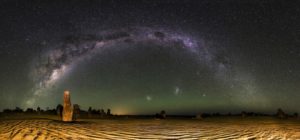The Milky Way arching over the Large and Small Magellanic Clouds
Perth, MINA — A radio telescope in outback Western Australia has been utilized to watch radiation from infinite beams in two neighboring cosmic systems, demonstrating zones of star development and echoes of past supernovae, Techexplorist reported.
The Murchison Widefield Array (MWA) telescope could outline Large Magellanic Cloud and Small Magellanic Cloud systems in phenomenal detail as they orbit around the Milky Way. The Large and Small Magellanic Clouds are very close to our own Milky Way—less than 200,000 light years away—and can be seen in the night sky with the naked eye.
Also Read: UN Experts Warn Right Violations in Kashmir by Indian Authorities
By watching the sky at low frequencies, space experts distinguished cosmic rays and hot gas in the two galaxies and recognized patches where new stars are conceived and remainders from stellar explosions can be found.
International Centre for Radio Astronomy Research (ICRAR) astrophysicist Professor Lister Staveley-Smith said, “Cosmic rays are very energetic charged particles that interact with magnetic fields to create radiation we can see with radio telescopes. These cosmic rays actually originate in supernova remnants—remnants from stars that exploded a long time ago.”
“The supernova explosions they come from are related to very massive stars, much more massive than our own Sun. The number of cosmic rays that are produced depends on the rate of formation of these massive stars millions of years ago.”
ICRAR astronomer Dr Bi-Qing For, who led the research, said, “This was the first time the galaxies had been mapped in detail at such low radio frequencies. Observing the Magellanic Clouds at these very low frequencies—between 76 and 227MHz—meant we could estimate the number of new stars being formed in these galaxies.”
Also Read: At Least Nine Children and One Woman Killed in Pakistani Airstrike on Afghanistan
“We found that the rate of star formation in the Large Magellanic Cloud is roughly equivalent to one new star the mass of our Sun being produced every ten years. In the Small Magellanic Cloud, the rate of star formation is roughly equivalent to one new star the mass of our Sun every forty years.”
Professor Staveley-Smith said, “the results are an exciting glimpse into the science that will be possible with next-generation radio telescopes. It shows an indication of the results that we will see with the upgraded MWA, which now has twice the previous resolution.”
“Furthermore, the forthcoming Square Kilometre Array (SKA) will deliver exceptionally fine images. With the SKA the baselines are eight times longer again, so we’ll be able to do so much better.”
Scientists published their study in the journal The Monthly Notices of the Royal Astronomical Society. (T/RS5/RS1)
Also Read: Pakistan Condemns Israeli Settler Attacks in West Bank, Al-Aqsa Storming
Mi’raj Islamic News Agency (MINA)
































 Mina Indonesia
Mina Indonesia Mina Arabic
Mina Arabic